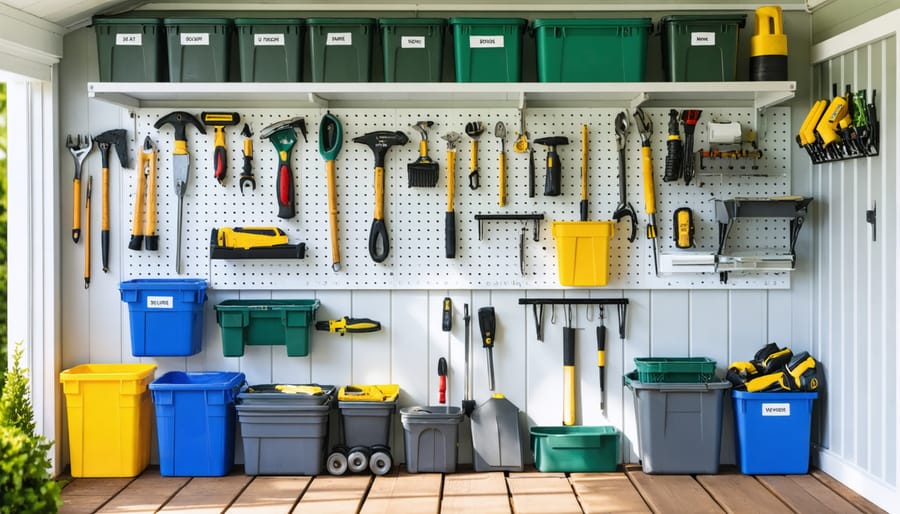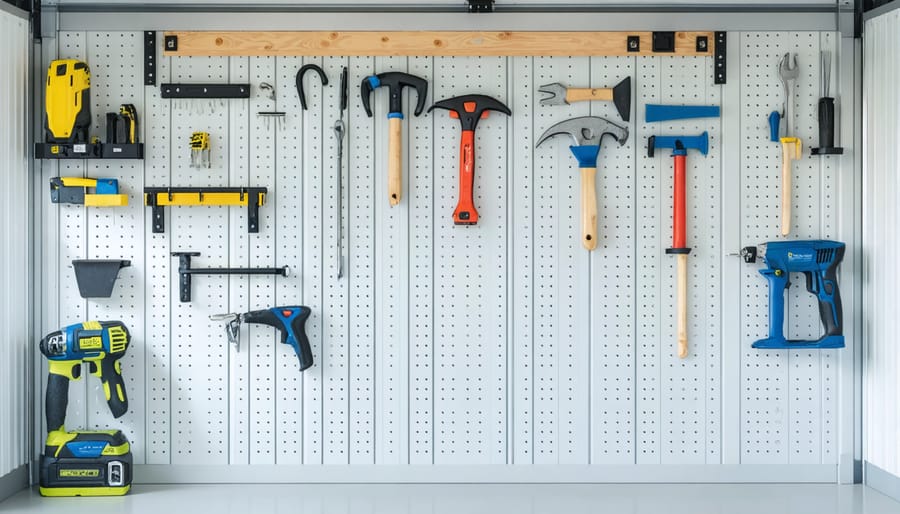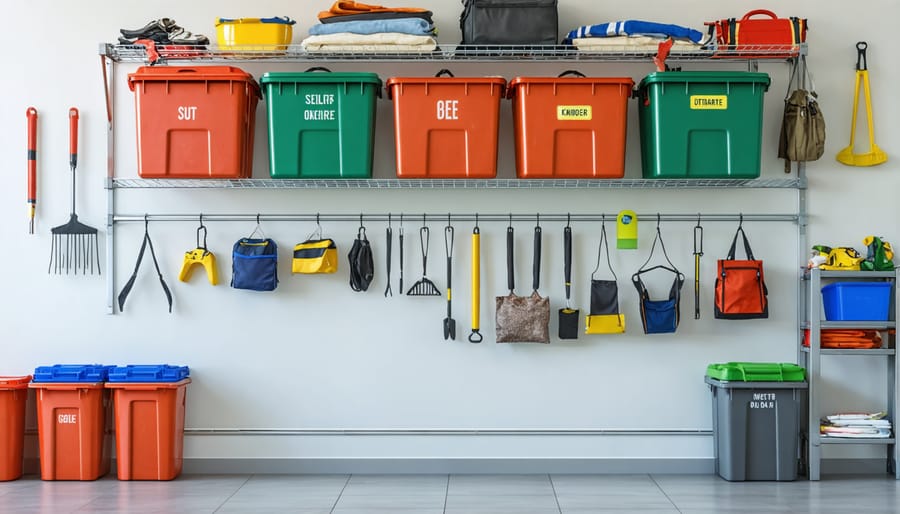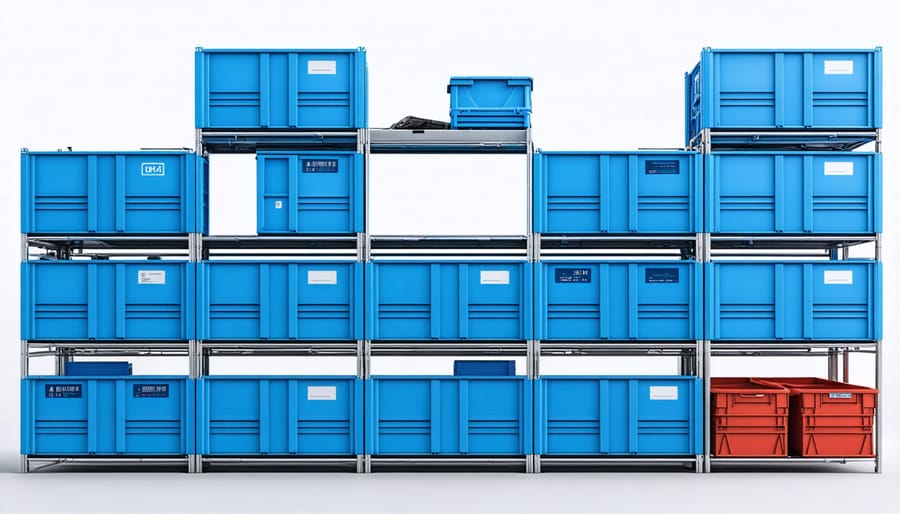10 Genius Ways to Double Your Shed Storage Space Today

Transform your cramped shed into a storage powerhouse by implementing vertical storage systems, installing adjustable shelving, and creating designated zones for different tools and equipment. Modern storage solutions can triple your usable space when you organize your shed effectively. Maximize overhead space with ceiling-mounted racks for seasonal items, utilize wall-mounted pegboards for frequently used tools, and incorporate modular bin systems for smaller items. Strategic organization not only increases storage capacity but also improves accessibility and maintains tool longevity. Clear pathways and labeled storage zones eliminate the frustration of searching for buried items while ensuring every square inch serves a purpose. Whether storing garden equipment, workshop tools, or household overflow, proper space utilization transforms a basic shed into an efficient, well-organized extension of your home.
Vertical Storage Solutions That Transform Your Space
Wall-Mounted Organization Systems
Transform your shed’s walls into efficient storage powerhouses with wall-mounted organization systems. Pegboards offer incredible versatility, allowing you to protect your stored tools while keeping them easily accessible. Simply install a pegboard panel on your shed wall, and you’ll have endless possibilities for arranging hooks, holders, and accessories to display and organize your equipment.
Slatwall systems provide a modern alternative to traditional pegboards, featuring horizontal grooves that accommodate various attachments. These systems are particularly sturdy and can handle heavier items like power tools and garden equipment. The best part? You can easily reconfigure your storage layout as your needs change throughout the seasons.
Don’t underestimate the power of well-placed hooks! Available in various sizes and styles, hooks can transform empty wall space into valuable storage real estate. J-hooks work wonders for hanging long-handled tools, while double-prong hooks are perfect for coiling hoses and extension cords. Consider using heavy-duty utility hooks for larger items like ladders and bicycles.
For maximum efficiency, organize your tools and equipment based on frequency of use. Keep commonly used items at eye level, seasonal tools slightly higher, and rarely used items up top. Remember to leave some space between items for easy access and to prevent overcrowding. This systematic approach ensures everything has its place while maintaining a clean, organized appearance.

Ceiling Storage Innovations
Don’t let valuable ceiling space go to waste! Overhead storage solutions can effectively double your shed’s storage capacity while keeping the floor clear for larger items. Ceiling-mounted storage racks are perfect for seasonal items, sports equipment, and lightweight storage bins. These sturdy racks typically attach directly to your shed’s joists and can support between 250-600 pounds when properly installed.
Consider installing a pulley system for items you need to access regularly. This ingenious solution allows you to lower and raise storage platforms with minimal effort, making it ideal for kayaks, bicycles, or storage containers. Modern pulley systems come with safety locks and can be operated single-handedly, ensuring both convenience and security.
For lighter items, cargo nets suspended from the ceiling provide flexible storage that’s easy to access. These are particularly useful for storing oddly shaped items like pool noodles, garden stakes, or holiday decorations. Another practical option is installing sliding storage tracks, which allow plastic bins to glide smoothly along ceiling-mounted rails.
When installing any ceiling storage solution, always check your shed’s structural integrity first. Position heavier items closer to the walls where the structure is typically strongest, and distribute weight evenly across multiple mounting points. Remember to leave enough headroom for comfortable movement underneath your storage installations.
Smart Zoning Strategies for Easy Access

Creating Functional Zones
Creating functional zones in your shed is one of the most effective ways to maximize storage efficiency and keep your items easily accessible. Start by dividing your shed into distinct areas based on usage patterns. Designate a workbench area for frequently used tools, complete with pegboards or magnetic strips for quick access. Create a seasonal zone for items like holiday decorations or garden equipment that you only need at specific times of the year.
Consider establishing a long-term storage section for rarely-used items towards the back of the shed, while keeping everyday tools near the entrance. Label each zone clearly and use color-coding if helpful. For garden tools, create a dedicated space with vertical storage solutions like tool hooks or specialized racks. Power tools deserve their own section, ideally with nearby electrical outlets and proper ventilation.
Don’t forget to include a “transition zone” near the entrance for items that move in and out frequently, such as lawn mowers or wheelbarrows. This prevents the need to constantly reorganize when accessing these items. Keep similar items together and use clear storage bins with labels to make finding specific tools or supplies quick and easy.
Traffic Flow Optimization
Efficient traffic flow in your shed is crucial for easy access to all your stored items. Start by creating a main walkway at least 3 feet wide through the center of your shed, connecting the entrance to the back wall. Think of this as your shed’s main street, with smaller paths branching off to different storage zones.
Place frequently used items like gardening tools and lawn equipment closest to the entrance for quick retrieval. Position seasonal items and less-used belongings toward the back of the shed. When arranging storage units along the walls, stagger their depths to create natural pathways – shallow shelves near the entrance gradually transitioning to deeper storage options toward the back.
Consider the swing radius of doors and any equipment you need to move in and out regularly. Leave enough clearance around power tools and larger equipment for safe operation. Use corner spaces for storing long-handled tools or installing diagonal shelving, maximizing typically unused areas while maintaining clear paths.
Mark your walkways with floor tape or paint to ensure they stay clear over time. This visual reminder helps prevent the common tendency to gradually encroach on walking spaces with new items. Remember, a well-planned traffic flow not only makes your shed more functional but also safer to use.
Space-Saving Storage Containers and Solutions
Stackable Storage Systems
Transform your shed into an organizational masterpiece with stackable storage systems that maximize every inch of space. Clear plastic bins are perfect for visibility and protection, allowing you to quickly locate items while keeping them safe from dust and moisture. Choose bins with secure, flat lids that enable stable stacking and consider color-coding them for different categories of items.
Modular cube storage units offer fantastic flexibility – you can add or remove sections as your storage needs change. These systems often come with removable bins or baskets, perfect for storing smaller items like gardening tools, paint supplies, or seasonal decorations. Look for units with adjustable shelving to accommodate items of varying heights.
Nesting storage boxes are another smart solution, especially for items you don’t access frequently. When not in use, these boxes fit inside one another, saving valuable space. For frequently accessed items, rolling storage carts with multiple drawers provide both organization and mobility.
Consider investing in heavy-duty plastic or metal shelving units specifically designed for stacking storage bins. These units often include weight ratings and safety features to prevent tipping. Remember to place heavier items in bottom bins and lighter ones on top. Label everything clearly, and maintain an inventory list to track what’s stored where – this simple step can save hours of searching later.

Custom Storage Solutions
Transform everyday items into smart storage solutions with a creative DIY approach. Empty plastic containers from bulk purchases make excellent small-parts organizers – just add labels for easy identification. Coffee cans, once cleaned and painted, become perfect holders for brushes, tools, and garden stakes. Consider mounting them on a pegboard wall for easy access.
Create custom shelving units using reclaimed wood or repurposed pallets. These can be sized exactly to fit your space and storage needs. Install adjustable shelf brackets to modify heights as your storage requirements change. For smaller items, try using mason jars mounted under wooden shelves – they’re perfect for storing nails, screws, and other hardware.
Maximize corner spaces with DIY triangular shelves or rotating lazy Susan-style platforms. Old plastic guttering, mounted horizontally, makes excellent storage for long items like dowels and trim pieces. Magnetic strips from old kitchen knife holders can be repurposed to hold metal tools on walls.
For seasonal items, vacuum-sealed storage bags can compress bulky materials like tarps and pool covers. Use clear plastic shoe organizers on the back of your shed door to store spray bottles, gloves, and small garden tools. Consider building pull-out drawers under workbenches for additional storage that doesn’t take up extra floor space.
Remember to label everything clearly and create an inventory system that works for you. Even simple solutions like color-coding containers or using numbered bins can make a significant difference in maintaining organization.
Maintenance Tips for Long-Term Organization
Seasonal Organization Schedule
A well-organized seasonal rotation schedule helps maintain an efficient shed throughout the year. Start with a spring cleanup in March or April, moving winter equipment like snow blowers and holiday decorations to the back while bringing gardening tools and lawn care equipment forward. Install clear bins labeled by season to make transitions smoother.
During summer months (June-August), ensure pool supplies, gardening tools, and outdoor entertaining items are easily accessible. Create a dedicated “summer zone” near the entrance for frequently used items. Come September, begin transitioning to fall storage, bringing leaf rakes, tarps, and winterizing supplies to the front while storing summer items away.
Winter organization (December-February) requires strategic placement of snow removal equipment and holiday decorations. Consider creating an overhead pulley system to maximize vertical space. Keep a quarterly checklist posted inside your shed door to track rotation schedules and maintenance tasks.
Remember to inspect items during each seasonal transition, disposing of broken equipment and updating your organization system as needed. This regular rotation not only keeps your shed organized but also helps preserve your tools and equipment.
Storage System Upkeep
Regular maintenance is key to ensuring your shed storage systems remain efficient and functional over time. To maintain your storage solutions, establish a quarterly cleaning schedule to dust shelves, hooks, and containers. Check for any loose screws or brackets on wall-mounted systems and tighten them promptly. Keep floors clear of debris and sweep regularly to prevent dirt from accumulating around stored items.
Inspect your storage containers every six months for signs of wear or damage. Replace any cracked bins or deteriorating cardboard boxes with sturdy alternatives. Label systems should be refreshed as needed – replace faded or peeling labels to maintain organization. If using clear containers, clean them periodically to maintain visibility of contents.
For moving parts like sliding systems or rolling carts, apply lubricant annually to keep them operating smoothly. Check weather stripping around doors and windows to protect stored items from moisture. Regularly assess your organization system’s effectiveness and make adjustments based on changing storage needs. This proactive approach helps prevent clutter from returning and ensures your storage solutions continue serving you effectively.
Safety Considerations for Maximized Storage
When maximizing your shed storage, safety should always be your top priority. Start by ensuring your shelving units and storage solutions are properly anchored to walls or floors to prevent tipping. Check weight limits for all storage solutions, and never exceed manufacturer recommendations, especially for overhead storage systems.
Keep heavy items at ground level or on lower shelves to maintain a low center of gravity. This reduces the risk of accidents when reaching for items and prevents shelf collapse. When using vertical storage, invest in a sturdy step ladder rather than relying on makeshift solutions like boxes or chairs.
Maintain clear pathways through your shed by keeping the floor free from obstacles. A good rule of thumb is to leave at least 36 inches of walking space in main areas. Install adequate lighting to prevent trips and falls, and consider motion-sensor lights for convenience and safety.
Be mindful of storing hazardous materials. Keep chemicals, fuels, and paint in their original containers and store them in well-ventilated areas away from heat sources. Use childproof locks if necessary, and always store these items out of children’s reach.
For tools with sharp edges, use protective covers or dedicated storage solutions. Mount power tools securely and keep cords neatly wrapped to prevent tripping hazards. Regular maintenance checks of your storage systems can help identify potential safety issues before they become problems.
Remember to consider weather protection, especially if your shed isn’t fully weatherproof. Use waterproof containers for vulnerable items and ensure proper ventilation to prevent mold growth and rust formation on tools.
Transforming your shed from a cluttered catchall to an organized storage haven is well within reach. By implementing vertical storage solutions, utilizing wall space effectively, and maintaining proper organization systems, you can double or even triple your usable storage space. Remember that the key to successful shed storage lies in regular maintenance and smart planning – taking time to categorize items, install appropriate shelving, and create designated zones for different tools and equipment.
Don’t feel overwhelmed by the process; start with one area at a time and build upon your success. Whether you’ve chosen to install pegboards, add ceiling storage, or incorporate bin systems, each improvement brings you closer to a more functional space. Keep in mind that maximizing your shed storage is an ongoing process that can be adjusted as your storage needs change.
By following the guidelines and tips we’ve discussed, you’ll create a storage solution that not only keeps your belongings organized but also makes them easily accessible when needed. Take action today – even small changes can lead to significant improvements in your shed’s storage capacity and functionality.

